
Why Custom Software is Overtaking Off-the-Shelf Solutions in 2025
October 10, 2025 / Bryan ReynoldsThe Future is Custom: Why the Custom Software Development Market is Set for Explosive Growth
The Multi-Billion Dollar Signal Every Leader Should Be Watching
When an organization's technology is evaluated, is it seen as a collection of operational tools or as a strategic weapon? This question is moving from the server room to the boardroom as a fundamental shift reshapes how market leaders compete. The explosive, multi-billion-dollar growth in the custom software development market is not a fleeting tech-industry trend; it is a clear, data-backed signal that forward-thinking organizations are moving away from generic, off-the-shelf solutions to build proprietary digital assets. This transition is a calculated strategy to codify their unique operational DNA into a sustainable, defensible competitive advantage.
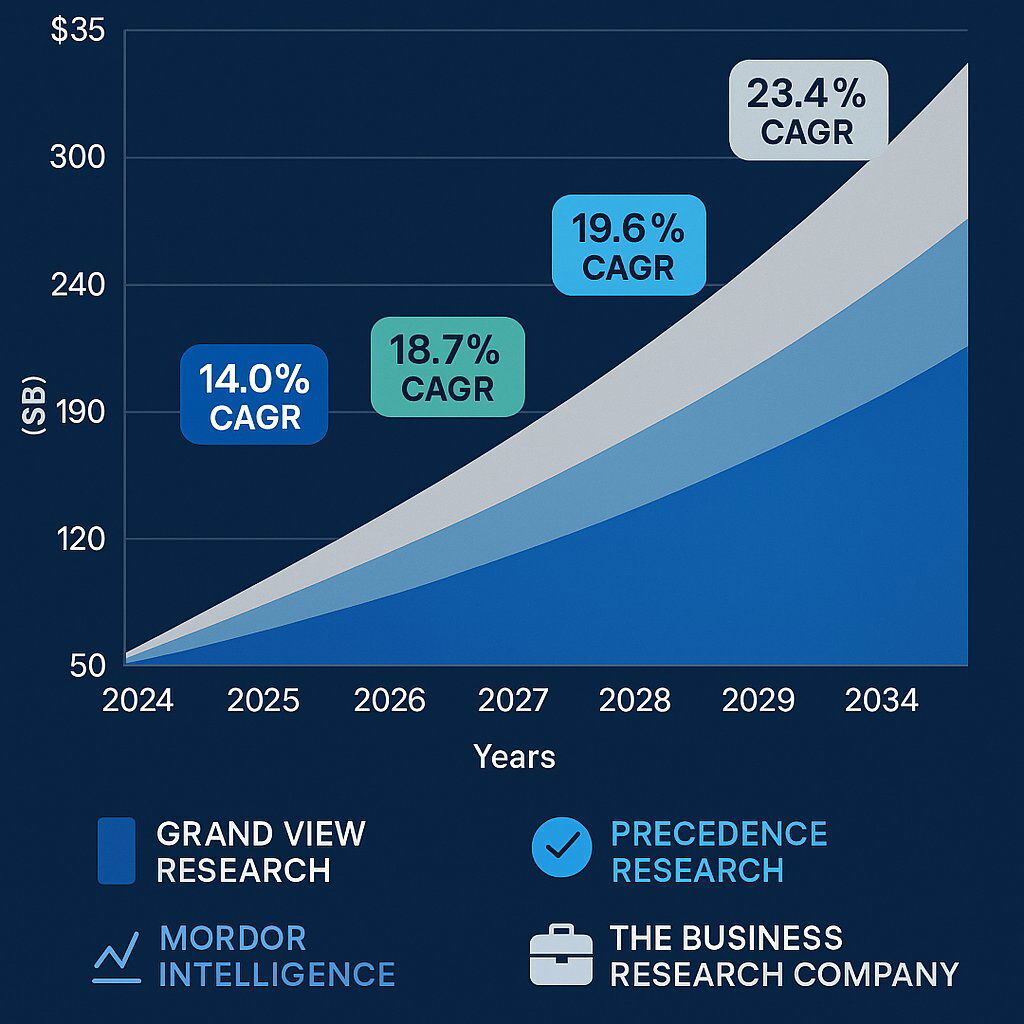
The evidence suggests that relying on the same commercial off-the-shelf (COTS) software as every competitor leads to process commoditization, creating a "sea of sameness" that makes true differentiation nearly impossible. In response, businesses are increasingly commissioning bespoke software to automate complex workflows, integrate disparate systems, and create unparalleled customer experiences. This report will examine the powerful market data fueling this surge, dissect the core drivers behind the custom software revolution, provide a clear financial framework for the critical "build vs. buy" decision, and offer actionable insights for strategic planning.
A Market Reshaped by Demand: The Data Behind the Surge
The trajectory of the custom software development market is a clear indicator of a profound strategic pivot across global industries. Valued at over USD 43 billion in 2024, the market is projected to experience a period of intense expansion. Forecasts vary based on methodology, but the directional trend is unambiguous and powerful. Projections show the market climbing to over USD 146 billion by 2030, with some estimates reaching as high as USD 334 billion by 2034. This is not incremental growth; it is a market-wide transformation.
While different research firms present slightly different figures, the consensus points toward a sustained and aggressive Compound Annual Growth Rate (CAGR) that significantly outpaces general IT spending. Credible analyses place this growth rate in a range from a conservative 9.4% to a formidable 22.7% through the end of the decade. The U.S. market, a key bellwether, is demonstrating particularly robust momentum, with a projected CAGR between 18.5% and 22.9%. This data signals a decisive and accelerating shift in capital allocation toward building unique technological capabilities.
| Research Firm/Source | 2024/2025 Market Size (USD Billion) | Forecasted Market Size (USD Billion) & Year | Projected CAGR (%) |
|---|---|---|---|
| Grand View Research | $43.16 (2024) | $146.18 by 2030 | 22.6% (2025-2030) |
| Precedence Research | $43.21 (2024) | $334.49 by 2034 | 22.71% (2025-2034) |
| Mordor Intelligence | $43.21 (2025) | $99.68 by 2030 | 18.20% (2025-2030) |
| The Business Research Company | $44.52 (2024) | $117.67 by 2029 | 21.5% (2025-2029) |
Sources:
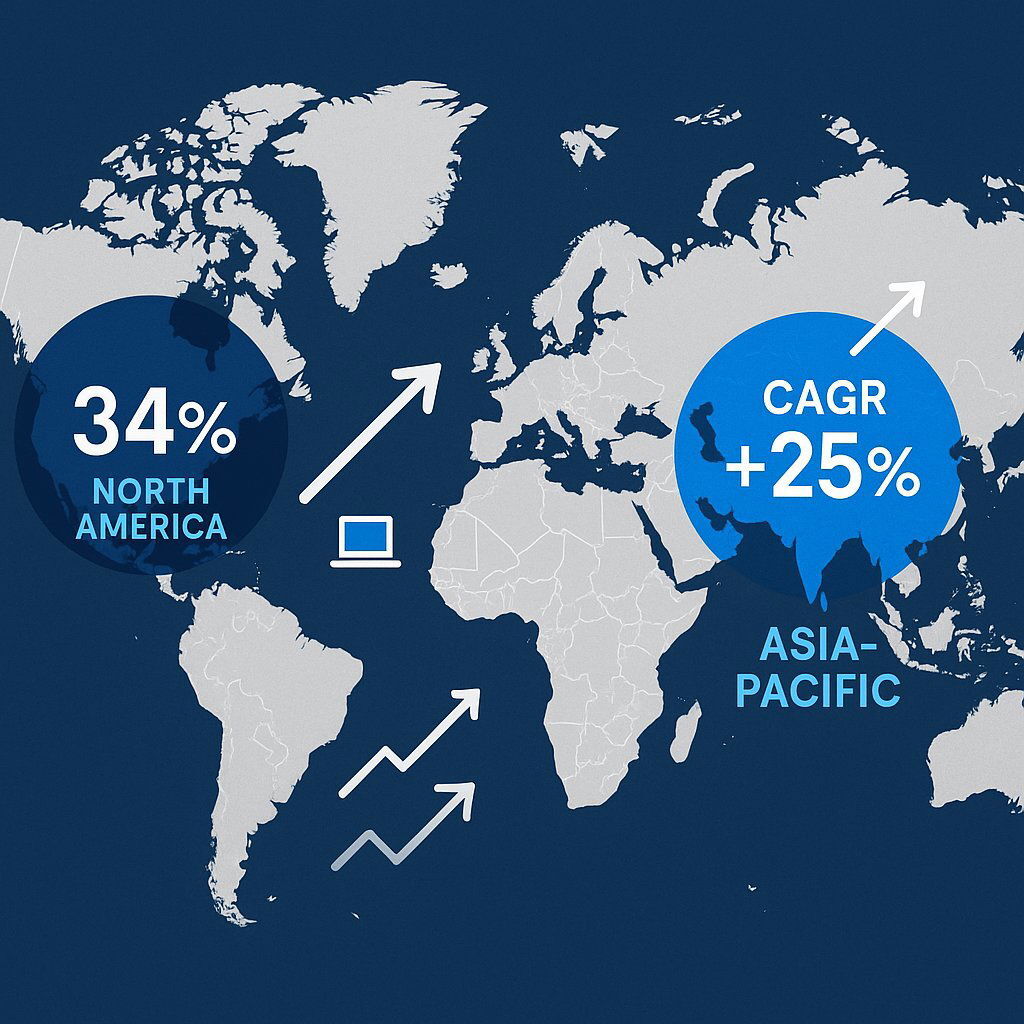
The regional dynamics of this growth are equally telling. While North America currently holds the dominant market position with approximately 34% of the global share, the most rapid expansion is forecast for the Asia-Pacific region, which is expected to grow at a CAGR of over 25%. This indicates not only a global diffusion of this strategic trend but also a shift in the global talent pool and innovation centers for custom development.
The Core Drivers of the Custom Revolution
Two fundamental forces are propelling this market expansion: the maturation of digital transformation from a buzzword into a core business function and the technological democratization that is empowering a new generation of agile competitors.
Driver 1: Digital Transformation as a Foundational Imperative
True digital transformation is not about simply adopting new software; it is about fundamentally re-engineering business processes to maximize efficiency, unlock new value, and elevate the customer experience. In this context, custom software serves as the engine of transformation, not merely a passenger. Its impact is realized through several key mechanisms:
- Automating Unique Workflows: COTS solutions, by design, cater to the lowest common denominator of business processes. They often force organizations to adapt their unique, value-creating workflows to the software's rigid constraints. Custom software does the opposite. It is meticulously crafted around a company's most critical and differentiating processes, amplifying what makes it competitive and leading to reported efficiency gains of 20-40%.
- Seamless Integration: In a typical enterprise, data is fragmented across a patchwork of legacy systems, CRMs, ERPs, and modern cloud applications. Custom software acts as the essential connective tissue, creating APIs and data pathways that break down these silos. This integration provides a unified, real-time view of the business, which is the bedrock of data-driven decision-making.
- Leveraging Advanced Technologies: Organizations are moving beyond experimenting with technologies like Artificial Intelligence (AI), Machine Learning (ML), and the Internet of Things (IoT). They are now seeking to embed them into core operations. Custom software provides the necessary platform to integrate these advanced capabilities directly into proprietary systems, turning them from isolated projects into fundamental business drivers.
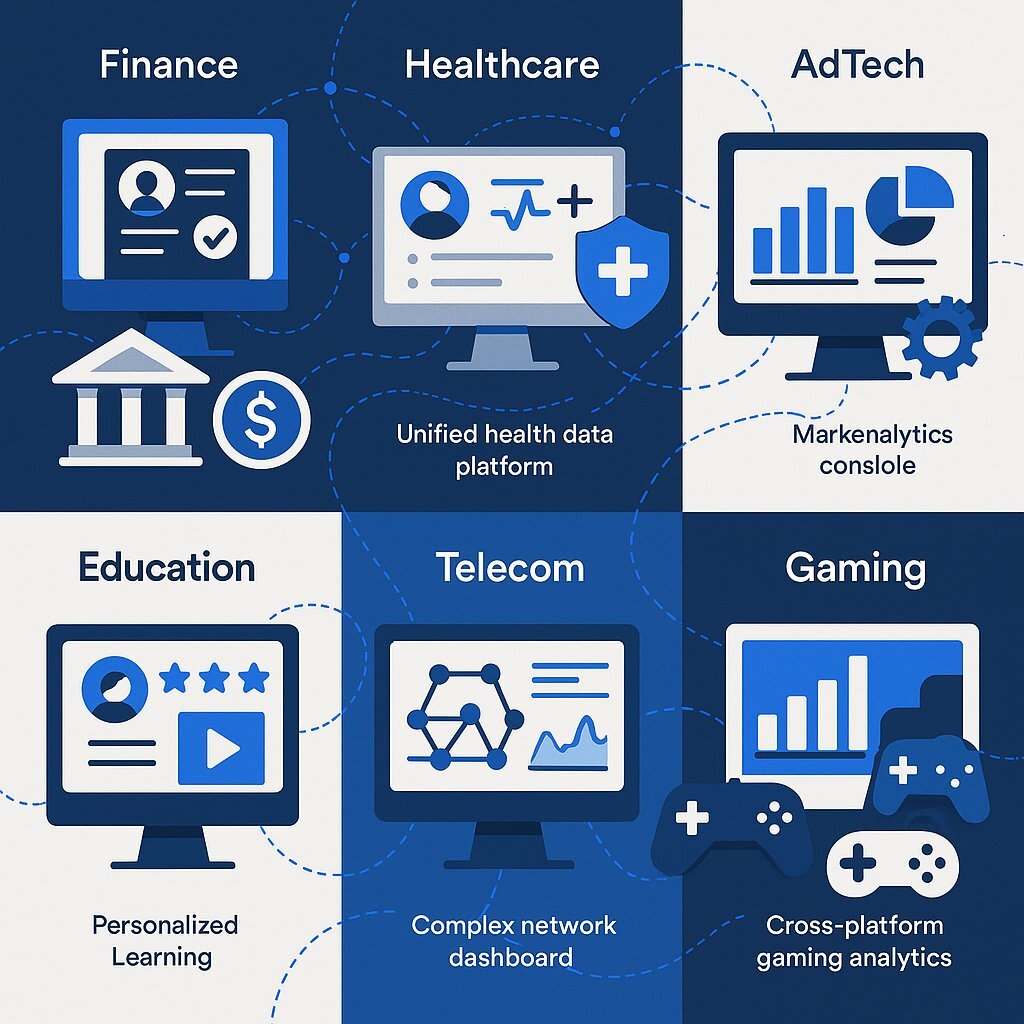
Driver 2: The Rise of the Agile SME
Historically, custom software development was a strategic luxury reserved for large enterprises with deep pockets. This paradigm has been completely overturned. Today, the Small and Medium-sized Enterprise (SME) segment is projected to be the fastest-growing adopter of custom solutions, fundamentally altering the competitive landscape. This democratization of technological power is enabled by two key trends:
- Cloud Computing: The overwhelming dominance of cloud deployment, which now accounts for over 58% of the market, has been a game-changer. It has replaced the need for prohibitive upfront capital expenditures on servers and infrastructure with a scalable, pay-as-you-go operational expense model. This shift lowers the barrier to entry, allowing SMEs to access enterprise-grade infrastructure without enterprise-grade budgets. For strategic guidance on adoption, see our cloud-native executive guide.
- Low-Code/No-Code (LCNC) Platforms: The proliferation of LCNC platforms is dramatically accelerating development timelines and reducing costs. These platforms use visual, drag-and-drop interfaces to empower smaller teams and even non-technical "citizen developers" to build and iterate on business applications. This trend is so significant that Gartner projects 70% of new business applications will be built using LCNC technologies by 2025, making custom solutions more accessible than ever.
These drivers converge at a critical strategic inflection point, particularly for mid-market companies. For decades, large enterprises have used custom software to build competitive moats. Now, technology has armed SMEs with the ability to do the same, allowing them to build highly efficient, differentiated systems without the legacy baggage of larger competitors. Mid-market firms that continue to rely solely on a COTS strategy risk being caught in a strategic vise: outmaneuvered by the agility and bespoke efficiency of smaller players from below, while simultaneously failing to match the deeply integrated, proprietary ecosystems of market leaders from above. The decision to invest in custom software is therefore becoming a key determinant of both survival and growth in this increasingly competitive middle ground.
The Strategic Imperative: Moving from "Off-the-Shelf" to "On-the-Mark"
The strategic choice is no longer simply about which software to buy, but whether to buy at all. Opting for a custom solution is a deliberate move away from the process commoditization that plagues many industries, and companies are increasingly building their own digital assets to secure a long-term ROI.
Breaking Free from the "Sea of Sameness"

When an entire industry runs on the same handful of COTS platforms—be it for CRM, ERP, or supply chain management—their core operational logic becomes standardized. They are bound by the same workflow constraints, the same feature sets, and the same vendor roadmaps. This creates a "sea of sameness" where sustainable competitive advantage is difficult to achieve. Custom software development is a strategic rebellion against this homogenization. It allows a company to build a defensible moat around its unique operational formula, turning its specific way of doing business into a proprietary, non-replicable asset. For a deeper dive on this trend, see why 75% of IT leaders are choosing custom software.
A CFO's Guide to Total Cost of Ownership (TCO) vs. Upfront Price
For the financial decision-maker, the low initial price of a COTS subscription can be alluring. However, a deeper analysis of the Total Cost of Ownership (TCO) often reveals a different financial reality. The sticker price is just the beginning; the true cost of COTS includes:
- Perpetual Licensing and Subscription Fees: These create a permanent operational expense that often escalates with user growth, penalizing scalability.
- Costly and Complex Integration: COTS platforms rarely work in isolation. Integrating them with other business-critical systems is often a complex, expensive, and fragile undertaking.
- Vendor Lock-In: Dependence on a single vendor for critical operations creates significant risk, exposing the business to price hikes, forced upgrades, or even the vendor's potential obsolescence.
- "Process Debt": This is the significant but often unmeasured cost of inefficiency. When software doesn't fit the process, employees are forced into manual workarounds, duplicate data entry, and other time-consuming tasks that erode productivity.
In contrast, custom software presents a different financial profile. While the upfront investment is higher, it is a capital expenditure that creates a long-term asset. It eliminates recurring license fees and is engineered from the ground up to automate processes and reduce operational costs, leading to a strong and measurable Return on Investment (ROI), often within two to three years.
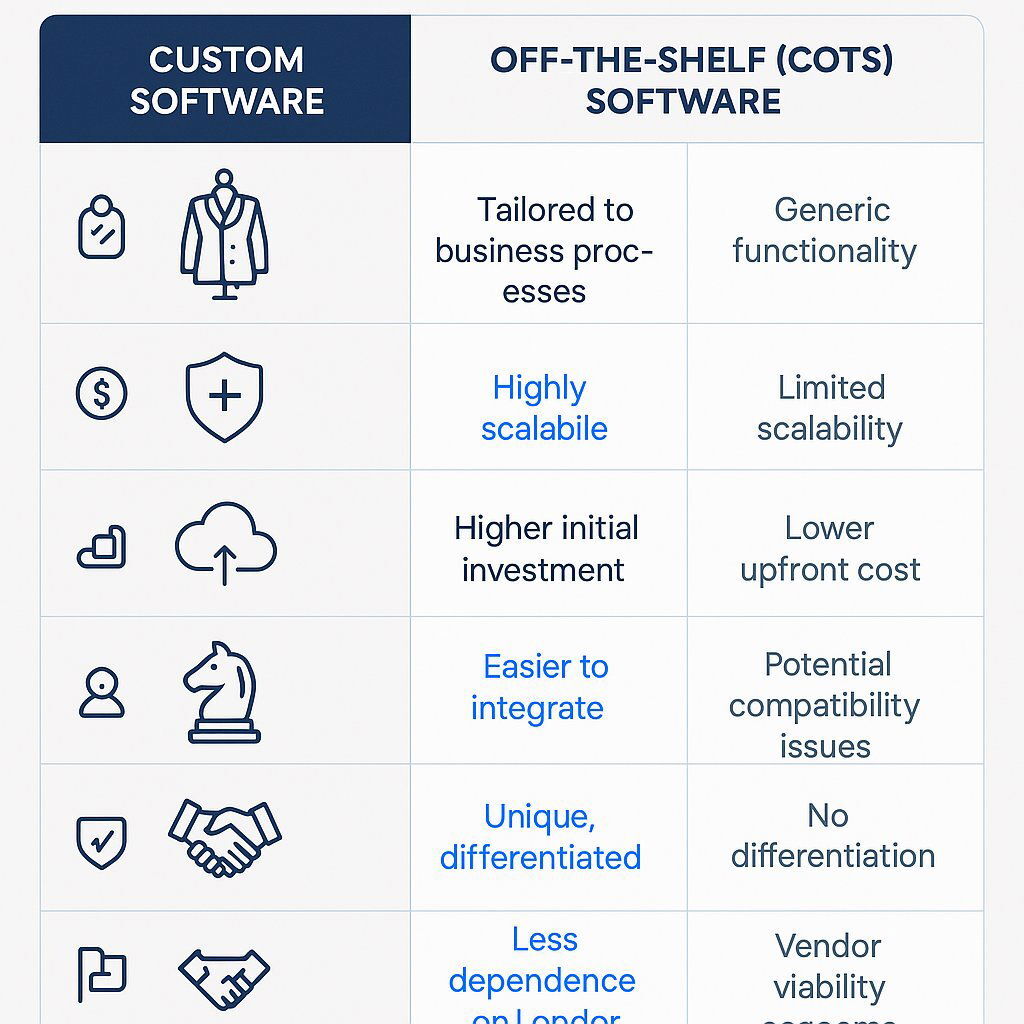
| Criteria | Custom Software | Off-the-Shelf (COTS) Software |
|---|---|---|
| Specificity & Process Alignment | Precisely tailored to unique organizational needs and workflows, ensuring perfect alignment with business processes. | Generic features designed for a broad market, often requiring businesses to adapt their processes to the software's limitations. |
| Scalability Model | Designed to scale from the outset, growing alongside the organization without punitive costs or architectural constraints. | Scalability often requires purchasing higher-tier plans or expensive add-ons, penalizing growth with escalating fees. |
| Cost Structure | Upfront capital investment that creates a long-term asset; lower TCO over 3-5 years. | Low initial cost but high, perpetual operational expense through subscription fees; higher TCO. |
| Integration | Designed for seamless integration with existing and future systems, creating a unified tech ecosystem. | Integration can be complex, costly, and fragile, often relying on third-party connectors. |
| Competitive Advantage | Creates a proprietary asset and a sustainable competitive moat based on unique processes. | Creates process parity with competitors, leading to a "sea of sameness." |
| Vendor Risk & Future Roadmap | Full ownership and control over the asset, its features, and its future development roadmap. | High dependency on the vendor's priorities, pricing models, support quality, and long-term viability. |
Sources:
Custom Solutions in Action: A View Across High-Growth Industries
The abstract benefits of custom software become concrete when examined through the lens of specific industry challenges. Across sectors, organizations are deploying bespoke solutions to solve complex, mission-critical problems that generic software cannot address. To see why a thorough upfront investigation is essential, explore the critical value of the Discovery Phase.
- Finance & Mortgage/Real Estate: This sector faces immense pressure from complex regulatory landscapes (e.g., GDPR, CCPA, HMDA), rigorous risk management, and the need for efficiency in the loan lifecycle. Custom platforms are being built to automate underwriting processes, integrate CRM and document management into a single workflow, and leverage AI for more accurate risk assessment and fraud detection, ensuring compliance while accelerating loan origination.
- Healthcare: The primary challenges are data interoperability between disparate Electronic Health Record (EHR) systems, ensuring ironclad patient data security under HIPAA, and reducing the immense administrative burden of medical billing. Custom software solutions create unified patient data platforms, enable secure communication channels for telehealth, and automate coding and billing workflows, which can reduce costly errors by up to 80%.
- AdTech/MarTech: In a data-saturated environment, the key challenges are gaining granular control over media buying, reducing operational costs, and managing vast datasets for precise audience targeting. Companies are building custom Demand-Side Platforms (DSPs) and marketing automation engines that provide full transparency and control over ad spend, enhance ROI, and ensure compliance with data privacy regulations.
- Education (LMS): Generic Learning Management Systems (LMS) often suffer from low user engagement, a lack of personalization, and poor integration with other administrative systems. Custom LMS platforms are solving these issues by incorporating tailored learning paths, gamification elements to boost engagement, robust analytics for tracking progress, and seamless integration with student information systems.
- Telecom: The telecom industry grapples with managing immense network complexity, automating intricate billing systems, and enhancing customer service in a hyper-competitive market. Custom Operations Support Systems (OSS) and Business Support Systems (BSS), bespoke CRMs, and network management tools are being deployed to improve operational efficiency, reduce billing errors, and provide a scalable foundation for next-generation technologies like 5G and IoT.
- Gaming: Success in the gaming industry hinges on creating unique gameplay experiences, managing massive volumes of player data for analytics, and ensuring seamless cross-platform compatibility. Studios are investing in custom game engines to create signature mechanics, bespoke analytics platforms to track player behavior and optimize monetization, and robust backend systems to manage multiplayer functionality and social features.
Building for Tomorrow: Hallmarks of a Successful Custom Software Initiative
Embarking on a custom software project is a significant strategic undertaking. Success depends on a business-led approach, modern development methodologies, and a solid technological foundation.
Strategy Before Code: The Business-Led Partnership
The most successful custom software projects are not treated as "IT projects" but as "business transformation initiatives." The process must begin with a deep and thorough analysis of strategic business goals, operational pain points, and desired outcomes. The project's success is defined by business metrics—such as increased efficiency, higher customer retention, or new revenue streams—not by a checklist of technical features.
The Power of Agile and Transparency
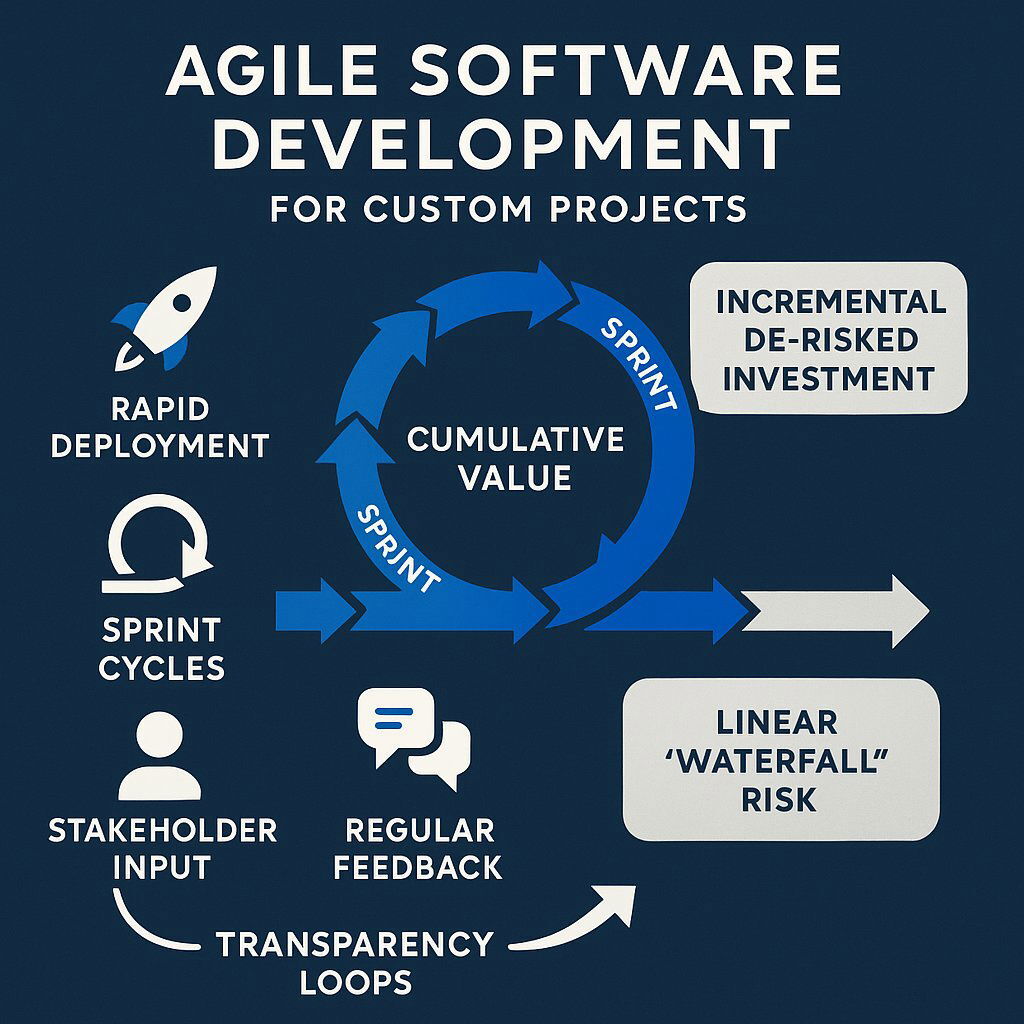
Traditional, long-cycle "waterfall" development methods introduce significant risk into large-scale projects. A modern Agile methodology mitigates this risk by breaking the project into short, iterative cycles called sprints. Instead of waiting 18 months for a single "big bang" launch, Agile delivers functional, tested pieces of the software every few weeks. This approach, often termed
Rapid Agile Deployment , ensures complete transparency. Stakeholders can see and test progress regularly, provide feedback, and make course corrections along the way. This gets a valuable product into the hands of users faster, allowing the organization to start generating ROI and gathering real-world feedback much earlier in the process.
From a financial standpoint, this methodology fundamentally de-risks the investment. A primary concern for any CFO is the risk of a total project write-off if business needs change or the final product fails to meet expectations after a long and costly development cycle. The waterfall method concentrates this entire financial risk at the very end of the project. Agile development transforms this risk profile by making the investment incremental. Each sprint is a small, contained investment that produces a tangible, testable result. This allows financial leaders to fund development iteratively, validating the investment at each stage. If a project needs to pivot or be cancelled, the decision can be made after a few sprints with a limited sunk cost, rather than after years and millions of dollars. Agile is not just a project management technique; it is a sophisticated financial de-risking strategy.
The Right Foundation: Why Your Tech Stack Matters
For a non-technical leader, the choice of underlying technologies—the "tech stack"—can seem like an implementation detail. In reality, it is a critical strategic decision that determines the software's long-term viability, performance, security, and scalability. Building on a modern, robust, and well-supported tech stack ensures the final product is a future-proof asset, not a piece of legacy code from day one. Choosing a foundation built on powerful, scalable technologies like
Kubernetes for container orchestration, proven cloud platforms like Azure , and efficient, enterprise-grade databases such as Postgres is essential. This is the essence of a Tailored Tech Advantage : crafting the solution with the right, cutting-edge tools to ensure security, performance, and long-term success. For companies considering a multi-layered container and DevOps setup, our DevOps services may offer foundational insights.
Conclusion: Your Next Move in the Custom Software Era
The evidence is conclusive. The powerful market growth, the fundamental strategic drivers, and the clear financial advantages all point to an inescapable logic: the move toward custom software is a deliberate shift by companies building resilient, defensible businesses for the digital age. The question for business leaders is no longer if they should consider building custom solutions, but where to begin targeting this strategy for maximum impact.
To move forward, organizations should consider the following actionable steps:
- Conduct a Strategic Technology Audit: Identify mission-critical business processes that are currently being forced into the constraints of generic, off-the-shelf software. Where does your operational uniqueness create friction with your tools?
- Initiate a True TCO Analysis: Task the finance team with modeling the five-year TCO of your key COTS platforms. This model must include not only licensing and support fees but also the costs of integration, customization, and a realistic estimate of the "process debt" incurred from manual workarounds.
- Identify a High-Impact Pilot Project: Rather than planning a massive, multi-year overhaul, identify a single, well-defined area of the business where a targeted custom application could drive significant and measurable efficiency gains or new revenue. Success here can build momentum and provide a clear business case for broader investment. To ensure post-launch value, review our guide to software maintenance mastery.
Building a proprietary digital asset is one of the most impactful strategic decisions a leadership team can make today. It is the process of turning your unique operational advantage into a tangible, scalable, and defensible asset.
Further Reading
- https://www.mckinsey.com/capabilities/mckinsey-digital/our-insights/the-digital-led-ceo
- https://www.forbes.com/sites/forbestechcouncil/2021/03/10/the-business-value-of-adopting-agile-development-methodologies/
About Baytech
At Baytech Consulting, we specialize in guiding businesses through this process, helping you build scalable, efficient, and high-performing software that evolves with your needs. Our MVP first approach helps our clients minimize upfront costs and maximize ROI. Ready to take the next step in your software development journey? Contact us today to learn how we can help you achieve your goals with a phased development approach.
About the Author

Bryan Reynolds is an accomplished technology executive with more than 25 years of experience leading innovation in the software industry. As the CEO and founder of Baytech Consulting, he has built a reputation for delivering custom software solutions that help businesses streamline operations, enhance customer experiences, and drive growth.
Bryan’s expertise spans custom software development, cloud infrastructure, artificial intelligence, and strategic business consulting, making him a trusted advisor and thought leader across a wide range of industries.


